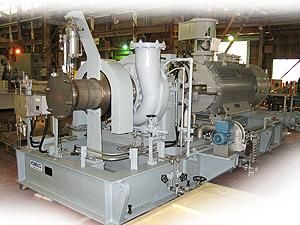Proper installation of centrifugal machinery

Below are excerpts from a paper titled, ‘Save your centrifugal machinery during commissioning’ presented at the 43rd Turbomachinery & 30th Pump Users Symposia (Pump & Turbo 2014) in Houston, TX from September 23 to 25, 2014. It was presented by Arun Kumar, Deputy General Manager, Maintenance & Reliability, and Mohit Sabharwal, Assistant General Manager, Maintenance & Reliability at Guru Gobind Singh Refinery. Both are currently working for HPCL-Mittal Energy Ltd., Bathinda, India.
A good foundation and proper installation are critical for successful commissioning. This article covers different equipment installation steps and standard practices and provides thumb rules and precautions for installation.
Foundation preparation
Ensure equipment foundations are as per approved drawings. As a thumb rule, the foundation block should be three times the mass of the equipment. Usually, pockets are left open for inserting the foundation bolts/anchor bolts. Pocket size should be sufficient to accommodate the foundation bolts with sleeve as well as minor movement of equipment to align with trailing or upstream equipment.
After installation and commissioning of equipment, equipment foundation should be epoxy painted (coating) to increase its life as well as to protect against soil pollution. Over a period of time, hydrocarbon and water ingress weaken the foundation.
Installation of leveling pad
Mark the centerline of foundation and center line of equipment. Check for the approximate position of equipment nozzles if applicable. Install the leveling plate using grout on leveling jack screw. If jack screws are provided, the base plate can be leveled using jack screw before grout filling. If leveling jack screws are not provided, base frame should be leveled on leveling plate directly. In such cases, leveling plate is fixed and leveled first and base frame is mounted on leveling plates.
Equipment erection
Usually the equipment is shipped on base frame and can be erected as a unit. If base frame is supplied separately, then base frame is to be erected and leveled first.
- Prior to erection of base plate, foundation bolt to sleeve clearance (freeness) is to be checked and foundation bolts with sleeve should be inserted into the pocket provided in the foundation block.
- Base frame is to be leveled on leveling plate or using jack screws to 0.02inch/ft. (0.17mm/m). All feet are to be leveled within 0.002 Inch (0.05mm).
- If required, the base frame bottom should be painted with epoxy grout primer.
- After leveling of base plate, all foundation pockets should be filled with epoxy grout.
- If the driver is mounted on a separate foundation, rough alignment is to be done prior to foundation bolts pocket filling to ensure alignment with upstream and downstream equipment.
- After curing of epoxy grout, foundation bolts are to be tightened to the desired torque.
- Complete base frame should be filled with epoxy grout through grout holes.
- All pedestal and mounting plates should be blue matched to ensure flatness of pedestals.
- Equipment and driver soft foot is to be checked. The maximum allowable limit is 0.002 inch (0.05mm).
Best practices
Soft foot checks and correction during erection phase itself may eliminate undesired vibration generated during trial run and last minute chaos during equipment trial runs. At the 9MMPTA refinery, proactive soft foot checks and correction on over 2000 machines resulted in no issues induced due to soft foot during commissioning. Alignment of equipment and driver is to be carried out and DBSE (Distance Between Shaft Ends) should be maintained as per the coupling drawing. DBSE checking and rough alignment of the machine should be done during foundation bolt pocket filling stage itself; necessary remedial action to be taken to maintain the equipment as per OEM alignment protocol.
It is usually recommended to place minimum 3-5 mm single shim plates on equipment (both driver and driven) foots to take care of alignment correction during hot alignment and consecutive overhauling after scheduled runs. Typically, steam turbines are kept lower than driven equipment to take care of thermal expansion during operation.
(Arun Kumar is currently working with HPCL- Mittal Energy Ltd., India as head of Maintenance & Reliability and is responsible for Maintenance & Reliability of a 9 MMTPA high complexity Refinery complex at Bathinda, India. Mohit Sabharwal is AGM, Maintenance & Planning in the Maintenance & Reliability team for HPCL - Mittal Energy Limited, Bathinda, India.)